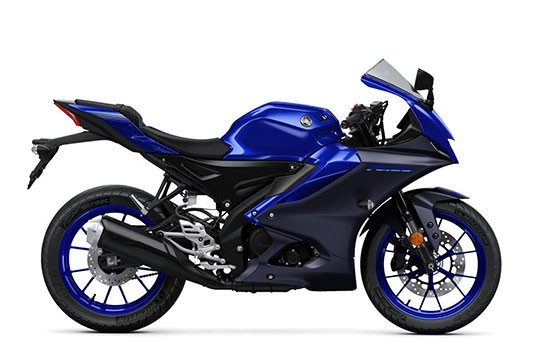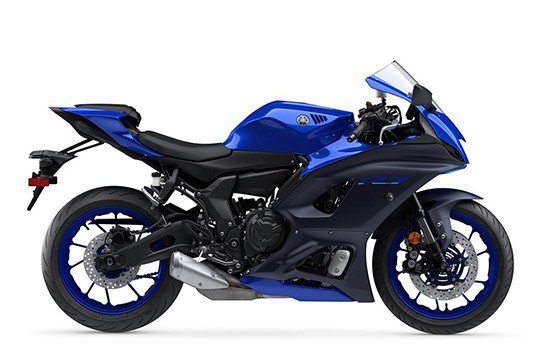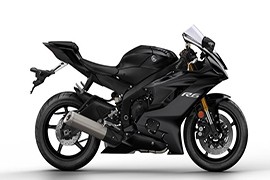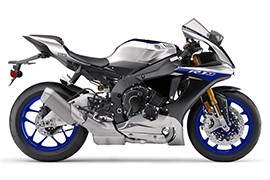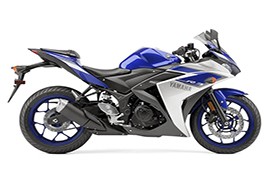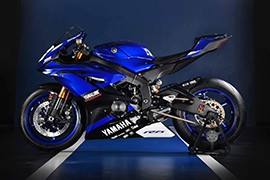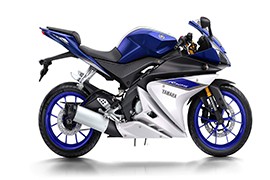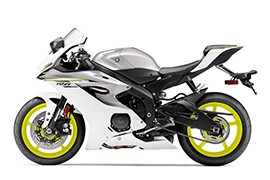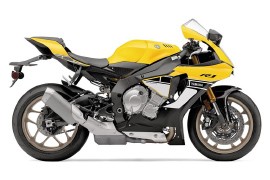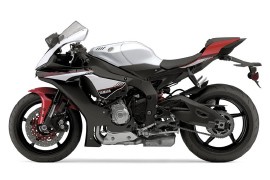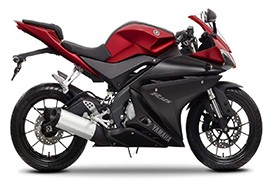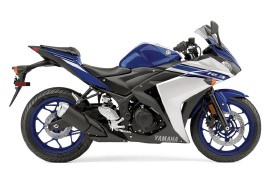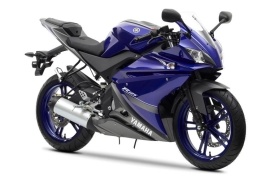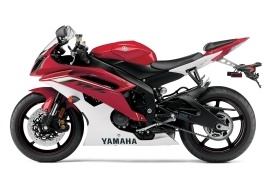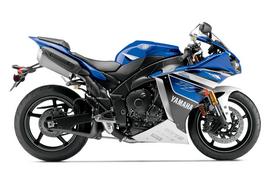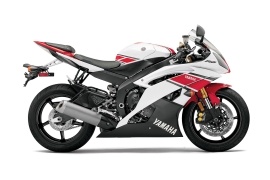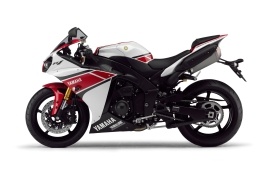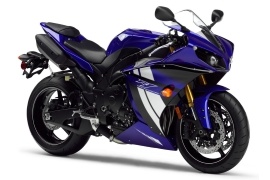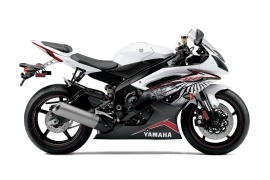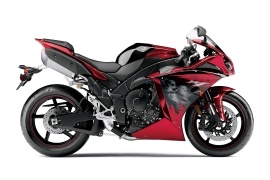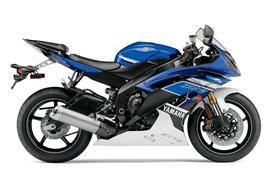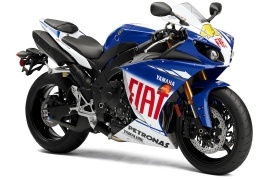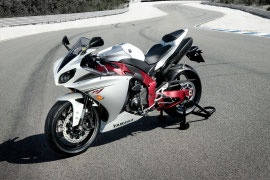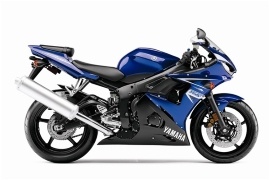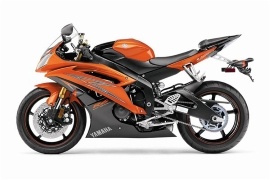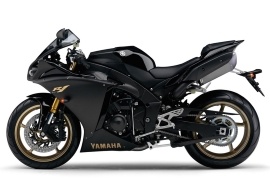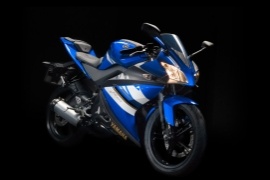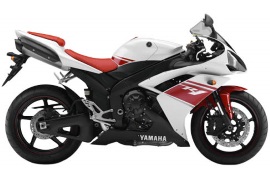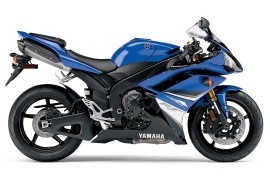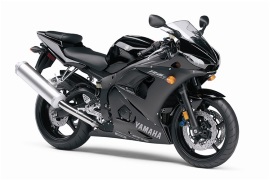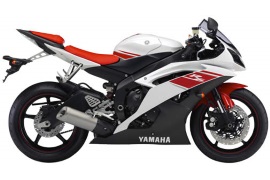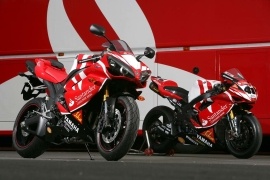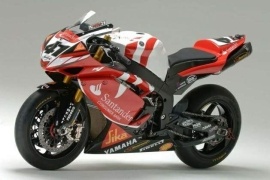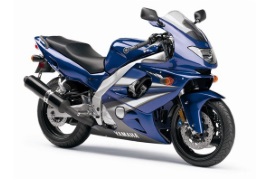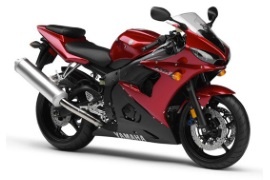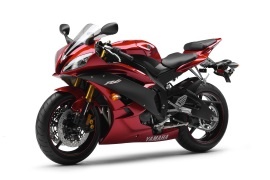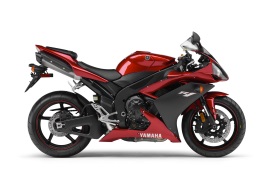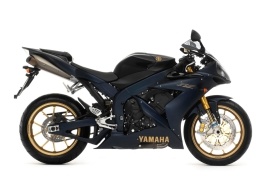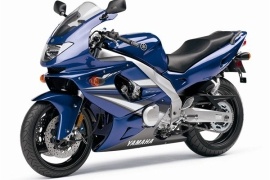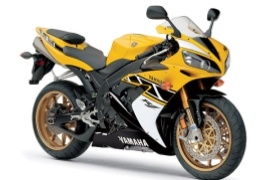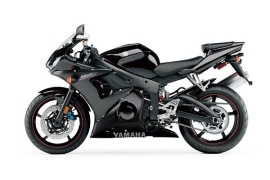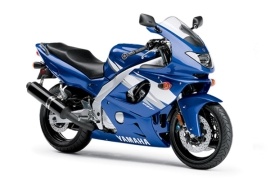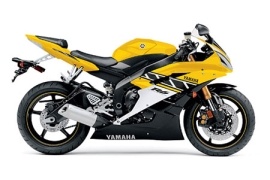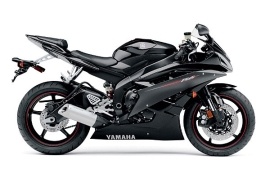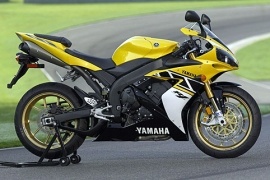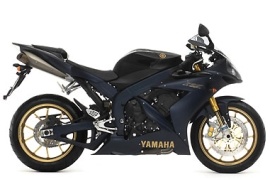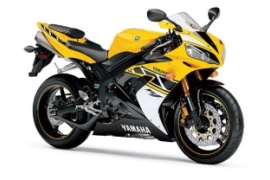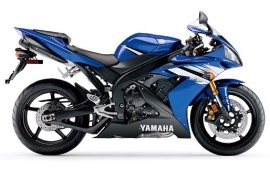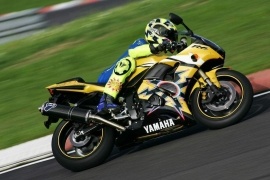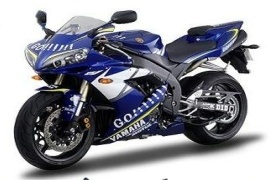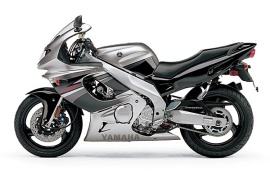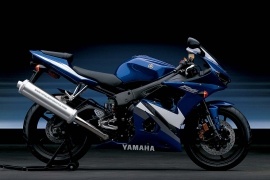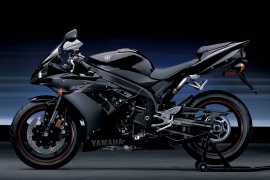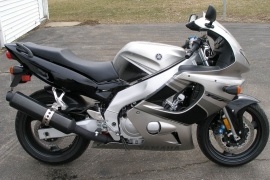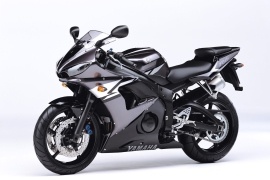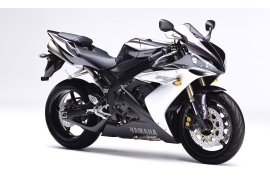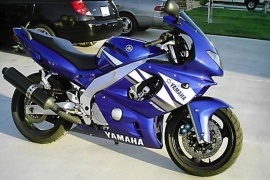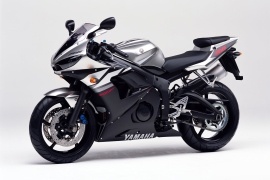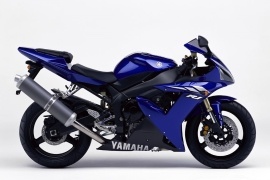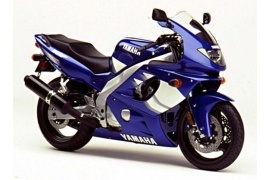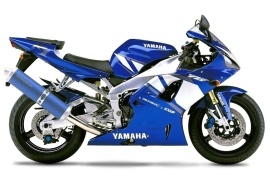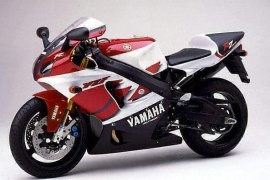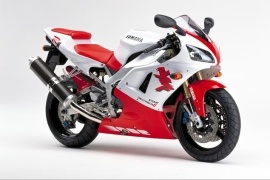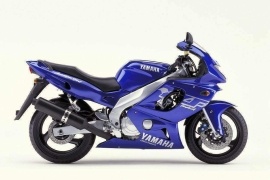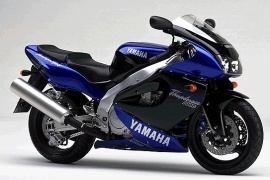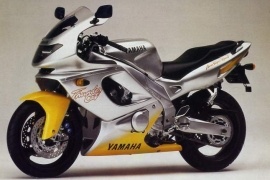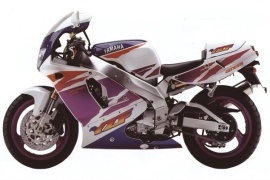YAMAHA YZF Models/Series Timeline, Specifications & Photos
First production year: 1993
In 2023, the Japanese motorcycle manufacturer prepared a new R125 motorcycle that featured race-developed Supersport geometry, with a Deltabox chassis fitted with a state-of-the-art 41 mm KYB upside-down fork on the front and a link-type rear suspension that offered agile handling.
The well-known triangle of the bike that included the footpegs, seat, and handlebar offered a sporty riding position for optimum control, while the five-inch TFT instruments with smartphone connectivity kept the rider informed at any time.
Also, the bike’s front end was equipped with a central LED headlight and dual LED position lights, while the M-shaped front fairing offered an aggressive appearance and an R-series vibe.
In the performance department, the 2023 Yamaha R125 was powered by a 125cc fours-troke liquid-cooled engine fitted with Yamaha's Variable Valve Actuation (VVA) technology, traction control system, and assist and slipper clutch that enhanced controllability at accelerating and decelerating.
As for the power figures, the 2023 Yamaha R125 delivered an output power of 15 hp with maximum strength at 10,000 rpm and 12 Nm (9 lb-ft) of torque available at 8,000 rpm.
In the ergonomics department, besides the M1 style MotoGP-inspired cockpit, the R125 machine was also equipped with a two-piece seat that featured thick foam for comfortable riding, an optimized handlebar position, aluminum rear set footpegs, and a slim-shaped fuel tank, which gave a balanced, sporty and comfortable riding experience.
A long time ago, in 1999, Yamaha came up with a race motorcycle called YZF-R7.
They only made 500 units, and they were designed to perform in the Superbike World Championship and Suzuka 8 Hours races - but we all know things don't always go as planned. Back then, it was hard for Yamaha to keep up with the racing updates, financially speaking, but when they finally did it, the crankshafts on the bikes failed. To simplify things and save money, Yamaha decided to detune the engine, as to meet the German maximum horsepower regulation. But that was not the best choice it could have done, because everyone that intended to buy the YZF-R7 was going to tune it back up from a street-legal bike to a race bike.
After almost two decades, Yamaha struck again, announcing on May 18, 2021 the production of a new supersport motorcycle, that shares the name with the 1999 YZF-R7. Also in 2021, the engine for the new YZF-R7 was updated to be Euro 5 compliant. The bike now has a 689cc liquid-cooled engine, rated at 73 hp at 8,750 rpm, and 67 Nm at 6,500 rpm. The new motorcycle was designed to be more aerodynamic, by compacting the engine and the front side and reducing the total weight down to 188 kg (414 pounds), decreasing the air resistance and making the new YZF-R7 flow through the air more easily.
The YZF-R7 even got a World GP 60TH Anniversary edition that was available from January 2022, with a starting price of $9,299 and many special touches.
Starting in 2008, Yamaha enriched the sport bike offering with the arrival of something called YZF-R125. By the time the range reached its 2018 model year, the family was already in its third generation.
The model was initially offered with a single-cylinder, liquid-cooled 125cc engine, a unit that has remained available across the range for all generations. Controlled using a 6-speed transmission, it develops just 15 hp at 9,000 rpm and 12.4 Nm of torque at 8,000 rpm.
Having gone through relatively small changes over the years, the 2018 Yamaha YZF-R125 added for this model year several things, including a new swingarm, frame, and body modifications, but also a new change to the frame and bodywork, a revised engine with Variable Valve Actuation (VVA).
In 2019, the model was also offered as a Monster Energy Yamaha MotoGP Edition, equipped with things like Assist and Slipper clutch, 41 mm upside-down front suspension, GP style handle crown, and a 140 mm rear tire. The bike maker called this version the “most exclusive 125 produced.”
Loved by young, beginner riders, the 2018 iteration of the bike (not the MotoGP one, of course) can still be had in 2022 for as little as 2,800 euros over in Europe, which is about the same in dollars at today’s exchange rates.
The YZF-R1 was a 1,000cc sports motorcycle manufactured by Yamaha in 1998, which received significant updates over the years. The bike started its life in 1998, right after Yamaha redesigned the Genesis engine into a more compact unit, which allowed a shorter wheelbase and an optimized center of gravity.
In 2017, the Japanese motorcycle manufacturer launched the Yamaha YZF-R1M, which was based on the Championship winning R1 machine and featured a unique riding experience with a linear and controllable power delivery thanks to its YRC electronic controls.
The bike featured a cross-plane engine, a short wheelbase chassis, 3D-controlled electronics, and carbon fiber bodywork that resulted in a special version of the R1 with even higher factory specifications.
For power, the bike packed a MotoGP-derived cross-plane engine that came in a compact and lightweight package, and as a first-ever on a production motorcycle, it featured titanium fracture-split connecting rods that delivered high horsepower and strong linear torque for massive performance.
As for the power figures, the 2017 Yamaha YZF-R1M had its heartbeat set by a 998cc four-stroke four-cylinder liquid-cooled engine that delivered an output power of 200 hp at 13,500 rpm and 112 Nm (83 lb-ft) of torque at 11,500 rpm.
For braking purposes, the model packed two 320 mm discs with four-piston calipers on the front wheel and a 220 mm disc with a single-piston caliper on the rear wheel.
In 2017, Yamaha launched the YZF-R3, a bike that fitted perfectly in the supersport range of the top-selling YZF-R125 and YZF-R6, a series that set the standards in the supersport world thanks to Yamaha's class-leading style, advanced technology, and unmatched performance.
The bike packed a lightweight diamond-type steel frame with a narrow, compact design and a low seating position, designed to offer a fun and enjoyable riding experience and more safe at the same time with the addition of the Antilock Braking System (ABS).
In the aesthetic department, the bike featured Yamaha's supersport-inspired styling with a full fairing design and a chassis that made it perfect for novice riders or more experienced ones that just wanted a light and nimble machine.
In addition, the bike packed a clip-on handlebar and a flat seat design with a low seating position that offered great comfort and a sporty riding style.
In the performance department, the 2017 Yamaha YZF-R3 had its heartbeat set by a 321cc four-stroke parallel twin-cylinder liquid-cooled engine designed for great performance with linear throttle response, low vibrations, and excellent fuel efficiency.
As for the power figures, the YZF-R3 motorcycle delivered an output power of 41 hp with a peak at 10,750 rpm and 30 Nm (22 lb-ft) of torque at 9,000 rpm.
For 2017, Team Blue will be racing in the 2017 FIM World SuperSport Championship with the new YZF-R6. With a class-leading, high-revving four-cylinder powerplant at its heart, the R6 already screams across the start/finish line ahead of the pack, but for 2017, the addition of traction control and D-Modes allow the rider to extract even more performance from the potent engine.
The Yamaha YZF-R125 was a motorcycle manufactured by Yamaha, which re-entered the supersport segment as a competitor to the Honda CBR125 model.
The bike was launched in 2008 in four different colors, such as Burning Blue, Midnight Black, Sports White, and Impact Yellow, while in 2009, it came in a Sunset Red livery and dropped the Impact Yellow livery.
The 2016 Yamaha YZF-R125 was the smallest bike manufactured by Yamaha but fitted with the latest technologies developed by the maker at the time and designed to offer great control at high speeds.
Also, the bike featured R6-inspired dual headlight fairing with race-type air intake between the headlights, a highly efficient fuel injection system, lightweight race-bred Y-shaped wheels with Y-shaped spokes, a forged aluminum rear brake pedal, and shift lever, and aluminum die-cast passenger footrests.
In the performance department, the bike took its thrust from a 124cc four-stroke single-cylinder liquid-cooled engine that delivered an output power of 15 hp with a peak at 9,000 rpm and 12 Nm (nine lb-ft) of torque available at 8,000 rpm.
The 2016 model featured the most sophisticated LCD instrument panels ever seen on a 125cc motorcycle at the time and an R6-inspired front cowl that offered a big bike look and feel topped by aerodynamic bodywork for maximum riding excitement.
Since its debut in 1999, the Yamaha YZF-R6 was the choice for advanced riders that benefited from MotoGP features and technologies wrapped in a lightweight package that delivered outstanding performance and handling.
In 2018, Yamaha launched the YZF-R6, a supersport motorcycle that featured a lightweight and compact engine with titanium valves and lightweight forged pistons that provided lots of horsepower, dressed in an aerodynamic front fairing with a windscreen that provided 8 percent improvement in drag force efficiency that resulted in a higher top speed on the track.
Already one of the most nimble machines in the supersport class, the 2017 model brought additional mass-centralization to the proven R6 package along with updated suspension for improved front-end feedback and greater cornering confidence.
The 2018 Yamaha YZF-R6 had at its core a 599cc four-stroke four-cylinder liquid-cooled engine that delivered an output power of 117 hp with a peak at 14,500 rpm and 62 Nm (56 lb-ft) of torque available at 10,500 rpm.
The bike packed the Yamaha Chip Controlled Throttle (YCC-T) system that offered crisp throttle response and the Yamaha Chip Controlled Intake (YCC-I) system that provided solid low rpm torque and power.
All features and technologies were packed on a lightweight and compact aluminum Deltabox frame that offered light and agile handling, with the engine used as a fully stressed member of the chassis that allowed a super-light main frame design.
The YZF-R1 was a 1,000cc sports motorcycle manufactured by Yamaha in 1998 and got significant updates over the years. The bike was launched in 1998 after redesigning the Genesis engine into a more compact unit, which allowed a shorter wheelbase and an optimized center of gravity.
Jumping over to 2016, Yamaha launched the YZF-R1, a motorcycle that packed MotoGP technology, along with a cross-plane engine design that delivered massive amounts of performance and unmatched handling.
The 2016 Yamaha YZF-R1 had at its core a 998cc four-stroke four-cylinder liquid-cooled engine that came in a lightweight and compact package with a cross-plane concept and dual injector system on each cylinder.
As for the power figures, the bike delivered an output power of 200 hp with a peak at 13,500 rpm and 112 Nm (83 lb-ft) of torque available at 11,500 rpm. All that power was converted into speed by a six-speed manual transmission with a multi-plate slipper clutch that spun the rear wheel through a lightweight O-ring chain drive.
For suspension, the bike packed a fully adjustable 43 mm KYB inverted telescopic fork on the front and a four-way adjustable piggyback KYB shock absorber on the rear, while the braking power was handled by two 320 mm discs with four-piston calipers on the front and a 220 mm disc with a single-piston caliper on the rear.
In 2016, Yamaha introduced the YZF-R1S, a less-expensive alternative to the standard R1 model, that featured the same electronic package and almost the same performance, which made the bike perfect for street use.
Some of the differences between the R1 and R1S included the five-spoke aluminum wheels that replaced the multi-spoke magnesium ones from the R1, the familiar 998cc engine with cross-plane crankshaft and titanium connecting rods were replaced by conventional steel ones, the oil pan along with the right side engine cover was made of aluminum instead of magnesium, and the titanium exhaust headers that replaced by ones made of stainless steel.
Most of the bike hardware was unchanged such as the chassis and suspension, but also the titanium muffler and the electronic package that offered traction control, wheelie control, launch control, and even slide control topped by Antilock Braking System (ABS).
In the power department, the 2016 Yamaha YZF-R1S motorcycle had its heartbeat set by a 998cc four-stroke four-cylinder liquid-cooled engine that delivered an output power of 200 hp at 13,500 rpm and 113 Nm (83 lb-ft) of torque with a peak at 11,500 rpm.
For suspension, the bike packed a fully adjustable Ohlins electronic inverted fork on the front and a fully adjustable Ohlins electronic single shock absorber on the rear.
In 2015, Yamaha released the YZF-R125, an exciting new member of the R family best suited for those riders who wanted to get acquainted with the basics of sports motorcycles.
Like its bigger brothers, the R125 model came in a Deltabox frame that delivered an optimum balance of strength and rigidity with class-leading performance but also with aggressive R-class styling and technology borrowed from the bigger bikes fitted in a smaller package.
The Deltabox frame, which formed the basis for riding comfort and handling performance, was designed for the best longitudinal, lateral, and torsional rigidity balance, with the engine used as a stressed member for batter strength and rigidity.
The 2015 Yamaha YZF-R125 featured R6-inspired dual headlight fairing with race-type air intake between the headlights, a highly efficient fuel injection system, lightweight race-bred Y-shaped wheels with Y-shaped spokes, forged aluminum rear brake pedal, and shift lever, and aluminum die-cast passenger footrests.
In the performance department, the bike had at its core a 124cc four-stroke single-cylinder liquid-cooled engine that delivered an output power of 15 hp with a peak at 9,000 rpm and 12 Nm (nine lb-ft) of torque available at 8,000 rpm.
For suspension, the bike packed a 41 mm upside-down telescopic fork on the front and a spring preload-adjustable monoshock absorber on the rear.
The Yamaha YZF-R3 was an entry-level sports motorcycle with a 321cc inline-twin engine made by the Japanese maker in 2015 and was the first motorcycle that featured an offset cylinder design.
The 2015 Yamaha YZF-R3 featured R-series styling with a full fairing design that offered a racetrack look and a low seating position, which made it perfect for a wide variety of riders looking for their first motorcycle or for those who simply wanted a lightweight and nimble machine.
The bike featured a newly designed steel frame and swingarm that housed a 41 mm KYB telescopic fork on the front and a KYB single shock absorber on the rear, linked to a set of 10-spoke cast aluminum wheels designed for strength and weight reduction.
As for braking performance, the 2015 Yamaha YZF-R3 packed a 298 mm disc squeezed by a two-piston caliper on the front wheel and a 220 mm disc with a single-piston caliper on the rear wheel.
In the performance department, the model featured a newly developed engine with a downdraft fuel injection system that offered easy starts and smooth performance under all conditions but also forged aluminum pistons just like its R1 and R6 siblings, which reduced weight and delivered excellent strength at higher temperatures.
As for the power figures, the 321cc four-stroke parallel twin-cylinder liquid-cooled engine delivered an output power of 41 hp with a peak at 10,750 rpm and 30 Nm (22 lb-ft) of torque available at 9,000 rpm.
In 2012, the Japanese motorcycle manufacturer released the Yamaha YZF-R125, which was a nifty motorcycle best suited for those riders who wanted to get acquainted with the basics of sports motorcycles.
With aggressive R-class styling and technology borrowed from the bigger bikes fitted in a smaller package, the YZF-R125 model offered top performance from its liquid-cooled single-cylinder engine and crisp handling thanks to its Deltabox aluminum frame and swingarm.
The model featured a newly designed middle cowl with an improved aerodynamic performance at higher speeds while also giving a more dynamic look to the bodywork. Also, the cowl featured a layered structure designed for better cooling efficiency that also provided comfort.
The Deltabox frame, which formed the basis for riding comfort and handling performance, was designed for the best longitudinal, lateral, and torsional rigidity balance, with the engine used as a stressed member for batter strength and rigidity.
In the power department, the 2012 Yamaha YZF-R125 had its heartbeat set by a 124cc four-stroke single-cylinder liquid-cooled engine that provided an output power of 17 hp with a peak at 8,500 rpm and 15 Nm (11 lb-ft) of torque available at 7,500 rpm.
The bike rolled on a set of five-spoke lightweight wheels with five pairs consisting of two thin spokes that provided strength, balance, and a light feel at the same time.
In 2013, Yamaha launched the YZF-R6, a bike developed with knowledge from countless years of racing history that reached new performance boundaries and pushed things even further into the reals of pure road aggression and adrenaline-drenched riding.
Less intimidating as a litter-class superbike such as its bigger R1 sister, the YZF-R6 was a machine capable enough to deliver awesome speed and a rewarding experience thanks to its Yamaha Chip Controlled Intake/Throttle system that delivered precise power.
Also, the engine was lightweight and compact, with lightweight titanium valves and forged pistons that provided fast engine response and a redline at 16,000 rpm.
The 2013 Yamaha YZF-R6 took its thrust from a 599cc four-stroke four-cylinder liquid-cooled engine that delivered an output power of 129 hp with a peak at 14,500 rpm and 66 Nm (48 lb-ft) of torque available at 11,500 rpm.
With a wet weight of 189 kg (416 lbs) and a six-speed manual transmission with a multi-plate slipper clutch, the YZF-R6 registered a top speed of 257 kph (160 mph).
For suspension, the bike packed a fully adjustable 41 mm inverted fork on the front that provided 115 mm of wheel travel and a fully adjustable piggyback shock absorber on the rear that offered 120 mm of wheel travel.
As for braking performance, the R6 packed two 310 mm discs squeezed by a couple of four-piston calipers on the front wheel and a 220 mm disc with a single-piston caliper on the rear wheel.
In 2012, Yamaha released the YZF-R1 motorcycle, which came with a bunch of changes and redesigns, such as the new aggressive headlight cowl designed for a sharper and more modern look, and LED position lights that enhanced the R1's unique styling.
In addition to the cross-plane crank with uneven firing order already owned, the bike took another big step in 2012 with the addition of MotoGP technology, such as the seven-level traction control and revised Electronic Control Unit (ECU) settings that allowed the rider to take out the full performance of the YZF-R1 bike.
Also, the bike received new silencer heat guards with restyled end caps for a more compact look, redesigned footrests for great boot sole contact, and new top triple clamps added to the appearance, reminding of the MotoGP YZR-M1.
In the power department, the 2012 Yamaha YZF-R1 featured an ultra-lightweight and compact engine with key components such as the cross-plane crankshaft and an uneven firing order that were also present on the Yamaha's Championship-winning M1 MotoGP racer.
With a 998cc four-stroke four-cylinder liquid-cooled engine, the Yamaha YZF-R1 delivered an output power of 182 hp at 12,500 rpm and 116 Nm (86 lb-ft) of torque at 10,000 rpm and the number one goal for the bike was more controllability rather than a horsepower increase.
With a dry weight of 177 kg (389 lbs) and set in motion by a six-speed manual transmission with a cable-operated multi-plate wet slipper clutch, the bike reached a top speed of 281 kph (175 mph).
In 2012, The Japanese motorcycle manufacturer released the YZF-R6 World GP 50th Anniversary Edition, a special edition motorcycle that commemorated half a century from the first GP race.
Over the past 50 years, Yamaha's racing program led to some of the most innovative engine and chassis technologies but also to the development of the most ground-breaking race-developed motorcycles like the YZF-R1 and YZR-M1.
The 2012 Yamaha YZF-R6 WorldGP 50th Anniversary Edition came in a Pearl White with Rapid Red delivery and included a 50th-anniversary emblem on top of the fuel tank and a special number plate that showed the limited number of motorcycles manufactured in this livery, which was 1,500 units produced worldwide.
In the performance department, the Anniversary Edition featured the same engine as the 2012 base model with the Yamaha Chip Controlled Throttle (YCC-T) system that offered flawless response under all conditions, titanium valves, and lightweight forged pistons that delivered fast engine response.
As for the power figures, the bike delivered an output power of 129 hp with a peak at 14,500 rpm and 66 Nm (48 lb-ft) of torque available at 11,500 rpm, which came out from a 599cc four-stroke four-cylinder liquid-cooled engine.
With a wet weight of 189 kg (416 lbs) and a six-speed manual transmission with a multi-plate slipper clutch, the bike registered a top speed of 257 kph (160 mph).
In 2012, Yamaha celebrated half a century since the first MotoGP racing motorcycle was born with the release of the Yamaha YZF-R1 WGP 50th Anniversary Edition, which came in a retro color livery with bright white and red accents complemented by the black trim of the belly pan, frame, engine, and wheels.
The YZF-R1 Anniversary Edition featured the same updates and changes as the 2012 base model, such as the seven-position traction control, revised Electronic Control Unit (ECU) settings, the redesigned footrests, the new headlight cowl, and the new silencer heat guards with new end caps that gave the bike a more compact look.
The world GP 50th Anniversary Edition celebrated Yamaha's racing heritage in a Pearl White and Rapid Red livery with a 50th Anniversary emblem on top of the fuel tank and a special number plate that showed the production number of only 2000 units manufactured worldwide in the special colors.
As for the power performance, the 2012 Yamaha YZF-R1 WGP 50th Anniversary Edition featured the same specifications as the 2012 base model, such as a 998cc four-stroke four-cylinder liquid-cooled engine that delivered an output power of 182 hp at 12,500 rpm and 116 Nm (86 lb-ft) of torque at 10,000 rpm.
The power produced by the engine, combined with a dry weight of 177 kg (389 lbs) and a six-speed manual transmission, resulted in a top speed of 281 kph (175 mph).
In 2012, Yamaha released the YZF-R1 motorcycle, which came with a bunch of changes and redesigns, such as the new aggressive headlight cowl designed for a sharper and more modern look, and LED position lights that enhanced the R1's unique styling.
In addition to the cross-plane crank with uneven firing order already owned, the bike took another big step in 2012 with the addition of MotoGP technology, such as the seven-level traction control and revised Electronic Control Unit (ECU) settings that allowed the rider to take out the full performance of the YZF-R1 bike.
Also, the bike received new silencer heat guards with restyled end caps for a more compact look, redesigned footrests for great boot sole contact, and new top triple clamps added to the appearance, reminding of the MotoGP YZR-M1.
In the power department, the 2012 Yamaha YZF-R1 featured an ultra-lightweight and compact engine with key components such as the cross-plane crankshaft and an uneven firing order that were also present on the Yamaha's Championship-winning M1 MotoGP racer.
With a 998cc four-stroke four-cylinder liquid-cooled engine, the Yamaha YZF-R1 delivered an output power of 182 hp at 12,500 rpm and 116 Nm (86 lb-ft) of torque at 10,000 rpm and the number one goal for the bike was more controllability rather than a horsepower increase.
With a dry weight of 177 kg (389 lbs) and set in motion by a six-speed manual transmission with a cable-operated multi-plate wet slipper clutch, the bike reached a top speed of 281 kph (175 mph).
In 2012, Yamaha launched the YZF-R6, a motorcycle loaded with top-notch technologies that provided a more rewarding experience for both daily riding and track days. The R6 was fitted with MotoGP technology and offered outstanding engine and chassis performance that was usually reserved for professional racers.
With the knowledge gained from all the racing years, the Yamaha YZF-R6 was a light and powerful machine, but also the most advanced motorcycle made by Yamaha at the time and the first production motorcycle that featured the Yamaha Chip Controlled Throttle (YCC-T) system that offered flawless response under all conditions.
The compact and lightweight engine featured lightweight titanium valves and lightweight forged pistons that provided incredible horsepower and a redline set at 16,000 rpm. The 599cc four-stroke four-cylinder liquid-cooled engine delivered an output power of 129 hp with a peak at 14,500 rpm and 66 Nm (48 lb-ft) of torque available at 11,500 rpm.
All that power was converted into speed by a six-speed manual transmission with a back-torque-limiting clutch that offered great braking and downshifting from high speeds while launching the bike to a top speed of 257 kph (160 mph).
In addition, the 2012 Yamaha YZF-R6 came with an adjustable front brake lever, a lightweight O-ring chain for reduced weight, a steering lock, a lightweight, low-maintenance sealed gel-type battery, and a lightweight aluminum side stand and chain adjusters.
In 2011, the Japanese motorcycle manufacturer launched the Yamaha YZF-R1, a MotoGP-inspired motorcycle that featured a cross-plane crankshaft design that offered an uneven firing order for outstanding controllable torque and unmatched throttle response.
The bike featured the D-MODE system that allowed the rider to choose between three engine maps that adjusted the performance based on riding preferences or road conditions. The Standard mode was designed for optimum overall performance, the "A" mode provided sportier engine response in the low-mid speed range, and the "B" mode offered less sharp response for situations that require sensitive throttle operation.
In the power department, the 2011 Yamaha YZF-R1 had its heartbeat set by a 998cc four-stroke four-cylinder liquid-cooled engine that delivered an output power of 182 hp with a peak at 12,500 rpm and 116 Nm (86 lb-ft) of torque available at 10,000 rpm.
All that power was converted into speed by a six-speed manual transmission that spun the rear wheel to a top speed of 281 kph (175 mph).
In addition, the bike featured race-inspired fairing with improved aerodynamics and style, a windshield with a "screw less" design for a cleaner appearance, a slim tail design, a seat that offered a sporty yet comfortable position, lightweight forged footpegs, and a low-maintenance, lightweight, sealed battery.
In 2011, the Japanese motorcycle manufacturer released the Yamaha YZF-R6, a race-derived motorcycle designed to take a lap in a minimal time.
Also, the bike was fun on the open road with its racing technologies wrapped in a supersport package that delivered unmatched handling and massive amounts of power.
The bike featured a compact and lightweight aluminum frame, which was a MotoGP-inspired innovation that offered optimized rigidity and light, agile handling with the engine used as a fully stressed member of the chassis that resulted in a super-light frame design.
Also, the bike packed a lightweight, detachable magnesium rear subframe and a lightweight aluminum swingarm that used a mix of castings and pressed plates that offered optimum rigidity.
As for performance, the 2011 Yamaha YZF-R6 had its heartbeat set by an ultra-compact, lightweight engine that featured titanium valves and forged pistons, which provided incredible horsepower and a red at 16,000 rpm.
As for the power figures, the bike delivered an output power of 129 hp with a peak at 14,500 rpm and 66 Nm (48 lb-ft) of torque at 11,500 rpm and converted into speed by a six-speed manual transmission with a multi-plate slipper clutch that spun the rear wheel to a top speed of 257 kph (160 mph).
The braking performance was handled by two 310 mm discs squeezed by a couple of four-piston calipers on the front wheel and a 220 mm disc with a single-piston caliper on the rear wheel.
In 2010, Yamaha released the YZF-R6, a motorcycle loaded with electronics and mechanical parts directly derived from Yamaha's racing program, but also a machine intended for experienced riders who were masters at handling the explosive power and torque available at every throttle twist.
The compact and lightweight aluminum frame was a MotoGP-inspired innovation that offered optimized rigidity and light, agile handling, with the engine used as a fully stressed member of the chassis that resulted in a super-light frame design.
Also, the bike packed a lightweight, detachable magnesium rear subframe and a lightweight aluminum swingarm that used a mix of castings and pressed plates that offered optimum rigidity.
For suspension, the bike packed a fully adjustable 41 mm inverted telescopic fork with 120 mm of wheel travel on the front and a fully adjustable piggyback monocross shock absorber on the rear that offered 120 mm of wheel travel.
In the performance department, the 2010 Yamaha YZF-R6 took its thrust from an ultra-compact, lightweight engine that featured titanium valves and forged pistons that provided incredible horsepower with a red line set at 16,000 rpm.
The 599cc four-stroke four-cylinder liquid-cooled engine featured the Yamaha Chip Controlled Throttle (YCC-T) system, which was a first for Yamaha, that delivered unmatched throttle response and improved controllability at high rpm.
As for the power figures, the bike delivered an output power of 129 hp with a peak at 14,500 rpm and 66 Nm (48 lb-ft) of torque at 11,500 rpm and converted into speed by a six-speed manual transmission that pushed the bike to a top speed of 257 kph (160 mph).
The Yamaha YZF-R1, also known as the R1, was a sports bike manufactured by Yamaha in 1998, replacing the Yamaha YZF1000R, and continued production until the present (2023). The bike underwent several significant modifications over its production period.
In 2009, the Japanese motorcycle manufacturer launched the Yamaha YZF-R1 LE US Edition, a hot limited-edition motorcycle with a livery inspired by Valentino Rossi's MotoGP winning bike.
The bike's color scheme retained the classic white and blue design, complemented by the Fiat logo and 46 racing number in a neon yellow for a more authentic look. In other departments, the bike packed the exact specifications as the 2009 base model.
The bike was built around an aluminum frame with a 43 mm fully adjustable inverted telescopic fork on the front, offering 120 mm of travel, and a fully adjustable shock absorber on the rear with 120 mm of travel, delivering excellent suspension performance and handling.
The braking performance was achieved by two 310 mm discs coupled to six-piston calipers on the front wheel and a 220 mm disc with a single-piston caliper on the rear wheel, providing excellent stopping power.
The 2009 Kawasaki YZF-R1 LE US Edition had installed a 998cc four-stroke four-cylinder liquid-cooled engine underneath its fuel tank, delivering an output power of 182 hp at 12,500 rpm and 115 Nm (85 lb-ft) torque at 10,000 rpm.
The YZF-R1 was a super-sport motorcycle manufactured by Yamaha Motor Company in 1998. In 2010, Yamaha launched the YZF-R1, which came with MotoGP technology from the M1, such as the cross-plane crankshaft design with an uneven firing order that provided controllable torque and unmatched throttle response.
The MotoGP-inspired YZF-R1 was the most advanced Open-class production motorcycle manufactured by Yamaha at the time and also the first that featured a cross-plane crankshaft, which resulted in incredibly smooth power delivery and massive torque for an unmatched riding experience.
The 2010 Yamaha YZF-R1 featured the D-MODE, with selectable throttle control maps that programmed the Yamaha Chip Controlled Throttle (YCC-T) to various performance characteristics in various riding conditions.
The system offered three engine maps such as the Standard, designed for optimum overall performance, the "A" mode, which provided sportier engine response in the low-mid speed range, and the "B" mode, which offered less sharp response for situations that require sensitive throttle operation.
As for power, the bike took its thrust from a 998cc four-stroke four-cylinder liquid-cooled engine that delivered an output power of 182 hp with a peak at 12,500 rpm and 116 Nm (86 lb-ft) of torque available at 10,000 rpm.
The power from the engine was converted into speed by a six-speed manual transmission that spun the rear wheel to a top speed of 281 kph (175 mph).
In 2009, Yamaha launched the YZF-R6S, a more civilized and street-friendly version of the R6 superbike, lightweight and powerful with razor-sharp handling and a comfortable cockpit that made it a do-it-all sports bike.
The lightweight aluminum Deltabox frame offered the perfect rigidity balance with its engine used as a stressed member and the removable aluminum rear subframe with fewer welding points that reduced weight, which resulted in a light frame design and great handling response.
In the performance department, the model featured an ultra-compact, lightweight engine with lightweight forged pistons for better engine response and a powerful 32-bit Electronic Control Unit (ECU) with computer-perfected mapping that provided precise ignition timing, maximum response, and more power output.
As for the power figures, the 2009 Yamaha YZF-R6S had its heartbeat set by a 599cc four-stroke four-cylinder liquid-cooled engine that delivered an output power of 129 hp with a peak at 14,500 rpm and 66 Nm (49 lb-ft) of torque available at 11,000 rpm.
For suspension, the model packed a 41 mm adjustable upside-down fork on the front and a fully adjustable shock absorber on the rear.
In addition, the model packed a durable, lightweight aluminum clip-on handlebar that reduced vibrations, an adjustable front brake lever, a special lightweight O-ring chain, a lightweight aluminum side stand, and chain adjusters, and a lightweight and low-maintenance sealed gel-type battery.
In 2009, the Japanese motorcycle manufacturer launched the Yamaha YZF-R6, a motorcycle that shared the updates with its liter-class sibling and brought forward a more powerful engine mounted in a new optimized frame with a design orientated on higher sporty performance.
For the 2009 model year, apart from the Black with Blue and White and Red with White paint jobs, the YZF-R6 was also available with a new livery such as the Orange with White colors.
The compact and lightweight aluminum Deltabox frame was a MotoGP-inspired innovation called the "straight frame concept" by Yamaha that offered optimized rigidity balance for a light and agile handling with the engine used as a fully stressed chassis member that offered a light frame design.
As for suspension, the bike packed a 41 mm inverted fork on the front that provided 120mm of wheel travel with ultra-precise feedback and a fully adjustable piggyback monocross absorber on the rear with 120 mm of wheel travel.
In the performance department, the bike featured a compact and lightweight engine with titanium intake and exhaust valves and lightweight forged pistons for fast engine response. The 2009 Yamaha YZF-R6 took its thrust from a 599cc four-stroke four-cylinder liquid-cooled engine that delivered an output power of 129 hp with a peak at 14,500 rpm and 66 Nm (49 lb-ft) of torque available at 11,000 rpm.
As for braking performance, the bike was stopped by two 310 mm discs squeezed by a couple of four-piston calipers on the front wheel and a 220 mm disc with a single-piston caliper on the rear wheel.
In 2009, Yamaha motorcycle manufacturer launched the YZF-R1, a sports bike that retained the acclaimed cross-plane crankshaft that delivered smooth, linear throttle response and an incredible feeling of connection to the bike and rear tire.
The bike featured the Yamaha Drive Mode (D-MODE) that allowed the rider to choose throttle control maps that programmed the YCC-T system for performance characteristics and riding conditions.
At a press of a button situated on the handlebar, the bike entered the "A" mode that provided sportier engine response in the low-mid speed range, the "B" mode that offered less sharp response for situations that required sensitive throttle operations, and the Standard Mode that offered performance for a variety of riding conditions.
As for power, the 2009 Yamaha YZF-R1 motorcycle featured a 998cc four-stroke four-cylinder liquid-cooled engine that delivered an output power of 182 hp at 12,500 rpm and 115 Nm (84 lb-ft) of torque available at 10,000 rpm.
For more rider comfort and power output, the newly designed engine adopted a coupling-type balancer that rotated in the opposite direction as the crankshaft and also featured forged aluminum pistons and lightweight titanium intake valves.
In addition, the Japanese manufacturer also made major changes to the Deltabox aluminum frame, upgraded the bodywork, and refined the independent damping fork performance for better cornering.
In 2008, the Japanese motorcycle manufacturer launched the Yamaha YZF-R125, an exciting new member of the R family, which aimed at the number one position in the 125cc sports market.
Like its bigger brothers, the R125 model came in a Deltabox frame that delivered an optimum balance of strength and rigidity with class-leading performance. Also, the twin-spar Deltabox frame was one of the lightest and best-handling frame designs that suited the supersport category.
The bike rolled on a set of lightweight cast-aluminum wheels shoded with the widest tires in its class that ensured high levels of traction and also underlined its position as the main contender in the 125cc sports class for 2008.
Some of the technical highlights featured by the bike included the cast aluminum swingarm, aggressive R-series styling, full-sized chassis and bodywork, two R-series styled headlights, a compact taillight, and sports riding position.
In the power department, the 2008 Yamaha YZF-R125 took its thrust from a 124cc four-stroke single-cylinder engine, their first liquid-cooled 125cc unit ever built, which delivered an output power of 17 hp with a peak at 8,500 rpm and 15 Nm (11 lb-ft) of torque available at 7,500 rpm.
The YZF-R125 was the most advanced 125cc machine ever built by Yamaha, with its high-revving, fuel-injected engine developed by the same engineers who created the legendary YZF-R1 and YZF-R6 supersport bikes.
In 2008, the Japanese motorcycle manufacturer launched the Yamaha YZF-R1 CE Canadian Edition, a bike that featured a bodywork combination of sparkling white and matte black panels adorned with fiery red accents, just like the similar R6 version.
The R1 motorcycle was the most technologically advanced sport bike ever made by Yamaha at the time, with MotoGP-derived features such as the chip-controlled throttle and electronically variable intake funnels that provided unmatched riding experience, confidence, and control.
Other benefits of the bike included the revised LED taillight, which came in a lighter package with a clear lens, the seat, which offered a sporty yet comfortable riding position, hollow bolts for weight reduction, fold out under seat bungee cord straps, lightweight forged footpegs, and low maintenance and lightweight sealed battery.
In the power department, the 2008 Yamaha YZF-R1 CE Canadian Edition featured the same technical specification as the base model with plenty of technologies and components derived from Yamaha's racing program.
The model featured at its core a 998cc four-stroke four-cylinder liquid-cooled engine that provided an output power of 180 hp with a peak at 12,500 rpm and 113 Nm (83 lb-ft) of torque available at 10,000 rpm.
With a dry weight of 177 kg (389 lbs) and set in motion by a six-speed manual transmission with a back-torque limiting clutch, the bike flew to a top speed of 288 kph (179 mph).
In 2008, Yamaha released the YZF-R1, a light and powerful machine that featured MotoGp technology and was the most advanced Open-class production motorcycle ever built at the time.
Also, the inline four-cylinder engine was the most powerful unit ever built by the Japanese manufacturer, with its world's first electronic variable-length intake fuel system and YCC-T fly-by-wire system that provided crisp throttle response under all conditions.
In addition, the aluminum Deltabox frame and swingarm took the Open-class handling to another level, while the slipper-clutch back-torque-limiting system offered great performance braking and downshifting from high speeds and the six-piston radial-mount front brake calipers with 310 mm discs generated strong braking performance.
In the power department, the 2008 Yamaha YZF-R1 had its heartbeat set by a 998cc four-stroke four-cylinder liquid-cooled engine that provided an output power of 180 hp with a peak at 12,500 rpm and 113 Nm (80 lb-ft) of torque available at 10,000 rpm.
All that power was converted into speed by a six-speed manual transmission, and with a dry weight of 177 kg (389 lbs), the bike reached a top speed of 288 kph (179 mph).
As for suspension, the model packed a 43 mm adjustable inverted telescopic fork on the front and a piggyback adjustable single shock absorber on the rear.
In 2008, Yamaha released the YZF-R6S, a motorcycle that, for the untrained eyes, was easily mistaken for its track-focused R6 sibling, but despite their similarities, there were two different beasts.
The R6S was the urban version of the R6, with a revised seating position and a slightly tamed engine that delivered the peak power and torque in the lower rpm range, an incredible combination of power, performance, and style that made it a do-it-all sports bike.
The lightweight aluminum Deltabox frame offered the perfect rigidity balance with its engine used as a stressed member and the removable aluminum rear subframe with fewer welding points that reduced weight, which resulted in a light frame design and great handling response.
In the performance department, the bike featured an ultra-compact, lightweight engine with lightweight forged pistons and a powerful 32-bit Electronic Control Unit (ECU) with computer-perfected mapping that provided precise ignition timing, maximum response, and power output.
The 2008 Yamaha YZF-R6S had at its core a 599cc four-stroke four-cylinder liquid-cooled engine that delivered an output power of 127 hp with a peak at 14,500 rpm and 66 Nm (49 lb-ft) of torque available at 11,000 rpm.
In addition, the bike featured a lightweight, durable clip-on handlebar that reduced vibrations, high premium Dunlop tires mounted on lightweight five-spoke wheels, a five-position adjustable front brake lever, an under-seat helmet holder, and fold-out bungee cord straps under the seat.
In 2008, the Japanese motorcycle manufacturer launched the Yamaha aYZF-R6 CE Canadian Edition, a special edition motorcycle, and as its name says, it was created specifically for the Canadian market only.
On the tech side, the bike featured the same specifications as the 2008 base model but offered a different livery, such as White with bright Red and Black accents with matching red rider and passenger seats, front fender, and rim stripes.
The bike featured the new compact and lightweight aluminum Deltabox MotoGP-inspired frame that used the engine as a fully stressed chassis member and offered a super light frame design and agile handling.
In the performance department, the compact, lightweight engine featured lightweight titanium valves and lightweight forged pistons with Yamaha Chip Controlled Throttle (YCC-T) system that provided great throttle response and a redline set at 16,000 rpm.
The 2008 Yamaha YZF-R6 CE Canadian Edition had its soul in a 599cc four-stroke four-cylinder liquid-cooled engine that delivered an output power of 129 hp with a peak at 14,500 rpm and 66 Nm (49 lb-ft) of torque available at 11,000 rpm.
In addition, the bike featured a lightweight aluminum clip-on handlebar that reduced vibrations, an adjustable brake lever, a lightweight aluminum side stand, aluminum chain adjusters, and a special Canadian Edition logo on the fuel tank.
In 1998, Yamaha launched the YZF-R1, a sports machine powered by a 998cc engine, also known as the R1. Over its production time, the bike went through significant upgrades in 2000. 2002, 2004, 2006, 2007, 2009, 2015, 2018, and 2020.
The 2000 model came with minor bodywork modifications that improved long-duration ride handling. The bodywork remained similar, with a sharpened headlight housing, more aerodynamic side panels, and a reshaped windshield that resulted in a three percent drag reduction. Also, Yamaha changed the engine management system, resulting in a smoother and broader power distribution.
The 2002 model introduced a new fuel injection system that didn't change the output power and remained the same as its predecessor's, while it packed new cylinder sleeves made of high silicon content, reducing thermal dissipation and oil consumption.
In 2004, the YZF-R1 came with styling updates, including an under-seat exhaust system and performance upgrades that included radial brakes and a ram air intake system, first fitted on a YZF machine.
In 2009, Yamaha launched a new YZF-R1 that took the engine technology from the M1 MotoGP motorcycle with its cross-plane crankshaft design. The 2009 R1 was the first production sports machine that packed a cross-plane crankshaft design.
In 2008, the Japanese maker released the Yamaha YZF-R1 10th Anniversary, a particular version of the YZF-R1 machine that commemorated the 10th anniversary of the R1 model. The specific edition model featured a unique paint scheme with exceptional anniversary graphics and decals.
Besides the unique edition color scheme and graphics, the 2008 Yamaha YZF-R1 10th Anniversary model had the exact specification as the standard model, with a 998cc four-stroke four-cylinder liquid-cooled engine, boasting 182 hp at 12,500 rpm and 116 Nm (85 lb-ft) of torque with peak power at 10,000 rpm.
The Yamaha YZF-R1, also known as simply R1 was a sports motorcycle manufactured by Yamaha in 1998 and powered by a 998cc engine. The bike received significant updates over its production run.
In 2000, the motorcycle received its first modifications and minor design changes that improved its capabilities. Although the power output was unchanged, the engine came with a revised management system that offered smoother and broader power distribution. The bike's bodywork was similar to the previous model, with a reshaped headlight housing, more aerodynamic side panels, and a reshaped windscreen for better protection, resulting in a three percent drag force reduction.
The 2002 model came with a new fuel injection system with a CV carburetor slide controlled by the engine vacuum and a power output similar to its predecessor. One significant improvement to the 2002 machine was the silicon content cylinder sleeves that reduced thermal distortion and oil consumption.
For the 2004 model, Yamaha made some significant changes that included an under-seat dual exhaust system, a radial braking system, and a ram-air intake for the first time. The bike's geometry was changed, and the engine was no longer used as a stressed chassis member.
In 2007, Yamaha released a new YZF-R1 machine with an all-new engine that packed four-valve per cylinder instead of the five-valve layout. Also, the bike came with a Yamaha Chip Control Intake (YCC-I) variable intake funnel system, Yamaha Chip Control Throttle (YCC-T) fly-by-wire system, a slipper clutch, a new aluminum Deltabox frame, and a new swingarm.
The 2007 Yamaha YZF-R1 came equipped with a 998cc four-stroke four-cylinder liquid-cooled powerplant, boasting 180 hp at 12,500 rpm, 189 hp with max ram air, and 113 Nm (83 lb-ft) torque at 10,000 rpm and 118 Nm with max ram air.
The Yamaha YZF-600R was a sports bike made by the Japanese motorcycle manufacturer from 1996 to 2007, while in the European market, the bike rolled as the Thundercat.
The model was introduced in 1996 as a replacement for the FZR-600R, and in 1997, during the European 600 SuperSport Championship season, the Thundercat was the only four-cylinder motorcycle that won against the Ducati 748.
Major mechanical components were retained from the FZR-600R, such as the engine, transmission, suspension components, and the steel Deltabox frame, and sold in the European market until 2003, while in the United States it lasted through 2008 with small aesthetic changes.
In 2007, Yamaha launched the YZF-600R, a more street-orientated bike that was almost identical to the older track-focused R6 model but differentiated by the one-piece two-up seat featured by the 600R model.
Created as a more tamed version of the R6, the YZF-600R was more suitable for daily rides and dedicated to those riders who were in search of a sporty middleweight machine that provided better comfort and enhanced useability.
In the power department, the 2007 Yamaha YZF-600R had its heartbeat set by a 599cc four-stroke four-cylinder liquid-cooled engine that delivered an output power of 100 hp with a peak at 11,500 rpm and 66 Nm (49 lb-ft) of torque at 9,500 rpm.
In 2007, Yamaha launched the YZF-R6S, a more civilized and street-friendly version of the R6 superbike, lightweight and powerful with razor-sharp handling and a comfortable cockpit that made it a do-it-all sports bike.
Unlike its supersport-derived sibling, the R6S packed a traditional fork and a set of tweaks and tricks to the engine that made the bike feel more reassuring on everyday ridings, even though the rev counter didn't go as high as the R6 model.
The YZF-R6S featured a lightweight and carefully tuned Deltabox frame and a Controlled-Fill swingarm that were key elements in the class-leading handling and performance with a removable CF die-cast rear subframe that was light and strong.
Some additional features of the bike were represented by the lightweight aluminum clip-on handlebars that reduced vibrations, a narrow fuel tank that offered great ergonomics and an aggressive seating position, a dual LED taillight design with excellent visibility and a sleek appearance, and a standard toolkit in a storage compartment under the passenger seat.
As for power, the 2007 Yamaha YZF-R6S featured a compact and lightweight 599cc four-stroke four-cylinder liquid-cooled engine with lightweight forged pistons that delivered an output power of 127 hp at 14,500 rpm and 66 Nm (49 lb-ft) of torque with a peak at 11,000 rpm.
Also, the four-two-one aluminum exhaust system was designed to optimize engine performance, reduced the overall weight, and featured a tucked-in high position for a maximum lean angle.
In 2007, Yamaha launched the YZF-R6, the smaller brother of the R1 model, which came with multiple tweaks for the engine and suspension, but also featured a unique Formula 1-inspired style and proved to be the machine of choice for those riders who didn't accept any compromises.
The bike had at its core an ultra-compact and lightweight engine with a cylinder head design that featured lightweight titanium valves for both intake and exhaust, lightweight forged pistons that provided high rpm power and fast engine response, lightweight crankshafts, and much more tweaks that raised the red line all the way up to 16,000 rpm.
As for the power figures, the 599cc four-stroke four-cylinder liquid-cooled engine delivered an output power of 125 hp with a peak at 14,500 rpm and 59 Nm (44 lb-ft) of torque available at 11,500 rpm.
All the power produced by the engine was converted into speed by a six-speed manual transmission with a back-torque-limiting clutch that spun the rear wheel to a top speed of 255 kph (158 mph).
In addition, the 2007 Yamaha YZF-R6 packed a durable and lightweight aluminum clip-on handlebar that offered optimal vibration damping, a narrow fuel tank that provided great ergonomics and an aggressive seating position, dual multi-reflector headlights with a sleek profile for better aerodynamics and visibility, a dual taillight design, and a standard toolkit located in a storage compartment under the passenger seat.
In 2007, the Japanese motorcycle manufacturer launched the Yamaha YZF-R1 motorcycle that came with a strong arsenal of awesome performance and good looks but also received a technology infusion and sharper styling.
The bike's engine was more powerful than the previous one and featured updated electronics, but it was an easier task to manage all the power, at least for more experienced riders. Also, the Deltabox V frame design offered better control and more rigidity, while the mass was centralized for a better, nimble feel.
The 2007 Yamaha YZF-R1 was a light and powerful bike that packed MotoGp technology and was the most advanced Open-class production motorcycle ever built at the time. The model featured a YCC-T fly-by-wire throttle system that provided perfect throttle response under all conditions and radial-mounted six-piston front brake calipers that generated strong braking performance.
At its core, the bike packed a 998cc four-stroke four-cylinder liquid-cooled engine that provided an output power of 180 hp with a peak at 12,500 rpm and 113 Nm (83 lb-ft) of torque available at 10,000 rpm.
When the power produced by the engine was combined with a six-speed manual transmission and a dry weight of 177 kg (389 lbs), the result was a top speed of 288 kph (178 mph).
As for suspension, the bike packed a 43 mm adjustable inverted telescopic fork on the front and an adjustable piggyback single shock absorber on the rear.
In 2006, Yamaha launched the YZF-R1 SP, a special edition model that came with an all-new engine with a traditional four-valve per cylinder design rather than a five-valve per cylinder set-up that Yamaha has employed since 1986.
The abandonment of the five-valve per-cylinder trademark allowed the construction of a higher-revving engine and broader power curve than the previous engine could produce. The engine was tweaked and delivered three horsepower more than the previous model.
As for the appearance, the 2006 Yamaha YZF-R1 SP model came with a Kenny Roberts replica paint scheme with yellow and black colors with attractive gold accents such as the wheels, badge, front fork, and silencers, while it still was easy on the eyes and capable of turning heads.
In the performance department, the model packed the same technical specifications as the base model, with a 998cc four-stroke four-cylinder liquid-cooled engine that delivered an output power of 174 hp at 12,500 rpm and 107 Nm (79 lb-ft) of torque at 10,500 rpm.
For suspension, the bike packed a 43 mm adjustable Ohlins inverted fork on the front and an adjustable Ohlins single shock absorber on the rear, while the braking power was achieved by two 320 mm discs with four-piston calipers on the front and a 220 mm disc with a four-piston caliper on the rear.
The Yamaha YZF-600R was a sports bike made by the Japanese motorcycle manufacturer from 1996 to 2007, while in the European market, the bike rolled as the Thundercat.
The model was introduced in 1996 as a replacement for the FZR-600R, and in 1997, during the European 600 SuperSport Championship season, the Thundercat was the only four-cylinder motorcycle that won against the Ducati 748.
Major mechanical components were retained from the FZR-600R, such as the engine, transmission, suspension components, and the steel Deltabox frame, and sold in the European market until 2003, while in the United States it lasted through 2008 with small aesthetic changes.
In 2007, Yamaha launched the YZF-600R, a more street-orientated bike that was almost identical to the older track-focused R6 model but differentiated by the one-piece two-up seat featured by the 600R model.
Created as a more tamed version of the R6, the YZF-600R was more suitable for daily rides and dedicated to those searching for a sporty middleweight machine that provided better comfort and enhanced useability.
In the power department, the 2007 Yamaha YZF-600R had its heartbeat set by a 599cc four-stroke four-cylinder liquid-cooled engine that delivered an output power of 100 hp with a peak at 11,500 rpm and 66 Nm (49 lb-ft) of torque at 9,500 rpm.
In 2006, the Japanese motorcycle manufacturer launched the Yamaha YZF-R1 50th Anniversary, a flagship superbike that marked half of a century.
The limited edition machine featured the same technical specifications as the base mode, such as the new cylinder head that added three more horsepower to the overall output, a longer swingarm, better compression, and revised forks for better handling.
The bike featured a Kenny Roberts replica paint scheme with yellow and black colors and custom Ohlins suspension, both front, and rear, developed by the same team that developed the YZR-M1 motorcycle.
Other features of the bike included the custom forged Marchesini aluminum wheels specifically designed for the model, which were 450 grams lighter, a back-torque-limiting clutch, and an integrated lap timer. For the United States, Yamaha only made 500 units.
In the performance department, the 2006 Yamaha YZF-R1 50th Anniversary model packed the same specifications as the base model, such as a power output of 174 hp at 12,500 rpm and 107 Nm (79 lb-ft) of torque at 10,500 rpm.
Set in motion by a six-speed manual transmission and with a dry weight of 174 kg (384 lbs), the bike reached a top speed of 288 kph (179 mph).
As for braking power, the bike packed two 320 mm discs with a couple of four-piston calipers on the front and a 220 mm disc with a four-piston caliper on the rear.
In 2006, Yamaha released a street version of the R6 model that featured almost identical bodywork and character but with a more civilian engine and transmission behavior.
So, the 2006 Yamaha YZF-R6S was hard to tell among other R6 machines, but the main thing that made the difference between the two models was the front fork, which on the R6 came with an upside down fork, while the R6S featured a normal telescopic fork.
The R6S offered a crisp throttle response and positive feedback at literally every twist of the throttle thanks to its ultra-compact, lightweight engine with a suction-piston-type fuel injection system and lightweight forged pistons.
The 2006 Yamaha YZF-R6S had its heartbeat set by a 599cc four-stroke four-cylinder liquid-cooled engine that delivered an output power of 127 hp with a peak at 14,500 rpm and 66 Nm (49 lb-ft) of torque at 11,000 rpm.
The bike featured a light and carefully tuned Deltabox frame and Controlled-Fill swingarm that housed a fully adjustable 43 mm telescopic fork on the front and a fully adjustable piggyback shock absorber on the rear that provided smooth suspension for the super-light five-spoke cast aluminum wheels.
As for braking power, the bike featured two 320 mm discs with four-piston calipers on the front wheel and a 220 mm disc with a single-piston caliper on the rear wheel.
In 2005, the Japanese motorcycle manufacturer launched the Yamaha YZF-600R, a great choice for those riders who enjoyed the zero-compromise performance offered by the R6 model but preferred some extra comfort.
The YZF-600R was a derivative of the supersport machine but tailored for a more linear response that offered a revised riding position with improved ergonomics thanks to its wide, plush seat, slightly rear-mounted footpegs, taller windshield, and fairings that provided a highly practical ride.
The legendary Deltabox chassis design was the perfect combination of lightweight and rigidity that delivered precise handling with its lightweight and compact rear subframe that provided better performance and more comfort.
The bike came from the factory with lightweight three-spoke cast aluminum wheels linked to a fully adjustable suspension both front and rear, while the braking power was handled by two 300 mm discs squeezed by a couple of four-piston calipers on the front and a 245 mm disc with a two-piston caliper on the rear.
As for power, the 2005 Yamaha YZF-600R took its thrust from a 599cc four-stroke four-cylinder liquid-cooled engine that delivered an output power of 100 hp at 11,500 rpm and 66 Nm (49 lb-ft) of torque with a peak at 9,500 rpm.
Set in motion by a six-speed manual transmission and with a dry weight of 189 kg (417 lbs), the model reached a top speed of 247 kph (153 mph).
In 2006, The Japanese motorcycle manufacturer released the Yamaha YZF-R6 50th Anniversary, a middleweight motorcycle that celebrated its 50th anniversary in the motorsports business, loaded with Yamaha-exclusive innovations and new technologies that made it the most advanced production motorcycle ever built at the time.
The engine featured new titanium valves and a red line at 17,500 rpm and was controlled by the first fly-by-wire system on a production motorcycle, all fitted in a MotoGP-derived chassis with Formula 1-styled aerodynamics complemented by a titanium exhaust system.
For suspension, the bike packed a 41 mm adjustable inverted telescopic fork on the front and a fully adjustable shock absorber on the rear, while the braking performance was handled by two 310 mm floating discs with four-piston calipers on the front wheel and 220 mm disc with a hydraulic caliper on the rear.
As for power, the 2006 Yamaha YZF-R6 50Th Anniversary model took its muscles from a 599cc four-stroke four-cylinder liquid-cooled engine that delivered an output power of 125 hp at 14,500 rpm and 59 Nm (44 lb-ft) of torque with a peak at 11,500 rpm.
Bolted to the engine, a six-speed manual transmission with a back-torque-limiting clutch converted the power produced by the engine into speed and pushed the bike to a top speed of 255 kph (158 mph).
In 2005, Yamaha launched the YZF-R6, a sports bike that came loaded with high-tech features that took the performance to another level and added even more to the spectacular on-road stance and maneuverability while offering riders a more precise feel behind the handlebars.
The engine received several upgrades for the 2005 model, such as bigger throttle bodies, a revised fuel injection system with ignition mapping, new camshafts and intake funnels, and much more that resulted in a three-horsepower increase with more power across the board.
Also, the model came with lighter and larger brake discs with new radial-mounted calipers that provided better braking performance, twin ring-type radiator fans for optimal engine cooling, and a revised headlight lens and revised under-cowl for an even better style.
In the power department, the 2005 Yamaha YZF-R6 had its heartbeat set by a 599cc four-stroke four-cylinder liquid-cooled engine that came in a lightweight and compact package that delivered an output power of 123 hp at 13,000 rpm and 69 Nm (51 lb-ft) of torque available at 12,000 rpm.
Also, the four-two-one aluminum exhaust system provided optimum engine performance, reduced overall weight, and was tucked in rather high for a maximum lean angle.
In addition, the bike featured durable, lightweight aluminum clip-on handlebars, a narrow fuel tank, and a standard tool kid under the passenger seat.
The United States market got its fair share of Yamaha YZF-R1 exclusive bikes with the YZF-R1 LE US Edition bike released in 2006 by the Japanese motorcycle manufacturer, based on the 50th Anniversary model whose livery shared.
Just like its Canadian sister, the YZF-R1 US Edition was equipped with premium Ohlins suspensions tailor-made for this model, and, unlike the Anniversary model, it came with golden forged Marchesini aluminum wheels shod with Pirelli Diablo Corsa tires and packed the same upgraded specifications received by the 2006 base model.
In the power department, the 2006 Yamaha YZF-R1 LE US Edition took its thrust from a 998 cc four-stroke four-cylinder liquid-cooled engine that delivered an output power of 174 hp with a peak at 12,500 rpm and 107 Nm (79 lb-ft) of torque available at 10,500 rpm.
The power produced by the engine, combined with a dry weight of 174 kg (384 lbs) and a six-speed manual transmission with a back torque-limiting slipper clutch, resulted in a top speed of 288 kph (179 mph).
As for braking performance, the model packed two 320 mm discs with four-piston calipers on the front and a single 220 mm disc with a four-piston caliper on the rear.
Also, the model came with gold-colored elements such as the front fork, wheels, exhaust covers, tank emblems, and a gold chain that enhanced the overall look of the bike.
In 2006, the Japanese motorcycle manufacturer launched the Yamaha YZF-R1 LE Canada Edition, an exclusive edition of the base model that received multiple aftermarket parts, turned into a special breed of beast available only for the Canadian market.
The LE Canada Edition motorcycle featured the same technical specifications as the base model, such as a new cylinder head that added three more horsepower to the overall output, a longer swingarm, a back torque-limiting slipper clutch, and Gold Marchesini forged aluminum wheels shod with Pirelli Diablo Corsa radial tires.
In the performance department, the 2006 Yamaha YZF-R1 LE Canada Edition model shared the same specifications as the base model, such as a power output of 174 hp at 12,500 rpm and 107 Nm (79 lb-ft) of torque at 10,500 rpm.
The bike was set in motion by a six-speed manual transmission, and thanks to a dry weight of 174 kg (384 lbs), it reached a top speed of 288 kph (179 mph). From top speed to a complete stop, the two 320 mm discs with four-piston calipers on the front and a single 220 mm disc with a four-piston caliper on the rear provided strong braking performance.
The 2006 Yamaha YZF-R1 LE Canada Edition featured a European-inspired Metallic Black and Dark Blue paint scheme and was manufactured in a limited number of 500 units for the United States and 500 units for the European market.
In 2006, the Japanese motorcycle manufacturer launched the Yamaha YZF-R1 50th Anniversary, a flagship superbike that marked half of a century.
The limited edition machine featured the same technical specifications as the base mode, such as the new cylinder head that added three more horsepower to the overall output, a longer swingarm, better compression, and revised forks for better handling.
The bike featured a Kenny Roberts replica paint scheme with yellow and black colors and custom Ohlins suspension, both front, and rear, developed by the same team that developed the YZR-M1 motorcycle.
Other features of the bike included the custom forged Marchesini aluminum wheels specifically designed for the model, which were 450 grams lighter, a back-torque-limiting clutch, and an integrated lap timer. For the United States, Yamaha only made 500 units.
In the performance department, the 2006 Yamaha YZF-R1 50th Anniversary model packed the same specifications as the base model, such as a power output of 174 hp at 12,500 rpm and 107 Nm (79 lb-ft) of torque at 10,500 rpm.
Set in motion by a six-speed manual transmission and with a dry weight of 174 kg (384 lbs), the bike reached a top speed of 288 kph (179 mph).
As for braking power, the bike packed two 320 mm discs with a couple of four-piston calipers on the front and a 220 mm disc with a four-piston caliper on the rear.
In 2006, Yamaha released the YZF-R1, a motorcycle that received various revisions, and also the manufacturer squeezed even more power from the 998cc engine. No less than three extra hp have been added thanks to the new cylinder head, while the 20 mm longer swingarm and modified frame offered better traction control and stability.
Also, that same year, Yamaha released the LE, a limited edition model in original Yamaha racing colors that celebrated its 50th anniversary. The LE model had custom Ohlins front and rear suspension developed by the same team as the YZR-M1 MotoGP bike. The limited edition LE model was made in 500 units for the United States and 500 units for the European market.
In the engine department, the 2006 Yamaha YZF-R1 had its soul in a 998cc four-stroke four-cylinder liquid-cooled engine that delivered an output power of 174 hp at 12,500 rpm and 107 Nm (79 lb-ft) of torque at 10,500 rpm.
Thanks to a dry weight of 174 kg (384 lbs) and a six-speed manual transmission, the model reached a top speed of 288 kph (179 mph).
As for braking performance, the bike packed two 320 mm discs with four-piston calipers on the front and a 220 mm disc with the four-piston caliper on the rear.
In 2005, Yamaha Launched the YZF-R6 Rossi R46, an exclusive new limited version of the R6 that featured eye-catching livery and graphics inspired by Valentino Rossi, the world's MotoGP Champion racer.
For the 2005 R6, Rossi, with the help of its designer, created a motorcycle that incorporated several of its personal styling icons, such as a split paint job with the sun on one side and the mood on the other and his famous 46 race number.
The specially designed motorcycle featured performance upgrades such as bigger throttle bodies, an improved fuel injection system, and revised intake funnels that offered a smoother, bigger powerband and more horsepower at 13,000 rpm.
As for the power figures, the 2005 Yamaha YZF-R6 Rossi R46 motorcycle had at its core a 599cc four-stroke four-cylinder liquid-cooled engine that provided an output power of 123 hp with a peak at 13,000 rpm and 69 Nm (51 lb-ft) of torque available at 12,000 rpm.
For suspension, the bike packed an adjustable 41 mm inverted telescopic fork on the front and an adjustable piggyback shock absorber on the rear, while the braking performance was provided by two 310 mm floating discs with radial-mounted four-piston calipers on the front wheel and one 220 mm disc with a single-piston caliper on the rear.
The Yamaha YZF-R1, also known as simply R1 was a sports bike manufactured by Yamaha from 1998, when it replaced the Yamaha YZF1000R until the present (2023). The bike debuted in 1998 and underwent significant modifications over its production time.
In 2005, the Japanese motorcycle manufacturer launched the Yamaha YZF1000 R1 MotoGP Replica, a sports machine replica of the actual bike that rode in the MotoGP race. It was part of the third generation and featured a new engine with excellent performance.
In the visual department, the motorcycle had standard features, such as a full fairing with a dual headlight system, a small windscreen, a single seat with lumbar support, an under-seat-mounted dual exhaust system, and lightweight wheels.
The bike was manufactured around a Deltabox V aluminum twin-spar frame with a 47 mm fully adjustable Kayaba inverted telescopic fork on the front, offering 120 mm of travel, and an adjustable shock absorber on the rear with 130 mm of travel, providing excellent suspension performance and handling.
The braking performance was achieved by two 320 mm discs tied to four-piston calipers on the front wheel and a 220 mm disc coupled to a four-piston caliper on the rear wheel, offering excellent stopping power.
As for power, the 2005 Yamaha YZF1000 R1 MotoGP Replica had installed a998cc four-stroke four-cylinder liquid-cooled engine underneath its fuel tank, delivering an output power of 170 hp at 12,500 rpm and 104 Nm (77 lb-ft) torque at 10,500 rpm.
In 2004, Yamaha launched the YZF-600R, a street-oriented bike almost identical to its R6 sibling and a perfectly balanced, versatile middleweight machine with an engine that provided low-mid range performance.
Also, the bike featured enhanced ergonomics with its wide, plush seat, slightly rear-mounted footpegs, taller windshield, and fairings that provided a highly practical ride.
The legendary twin-spar, diamond type, Deltabox steel frame, and swingarm were the perfect combination of lightweight and rigidity with precise handling and used the engine as a stressed member, which resulted in a more rigid chassis and enhanced handling performance.
On the front end of the chassis, the bike packed a fully adjustable 41 mm fork and a fully adjustable monocross shock absorber on the rear end that provided race-inspired suspension performance.
The bike rolled on a set of three-spoke cast aluminum wheels with reduced weight for better suspension performance with two 298 mm discs with four-piston calipers on the front and a 245 mm disc with a tow-piston caliper on the rear that provided strong braking performance.
In the power department, the 2004 Yamaha YZF-600R was brought to life by a 599cc four-stroke four-cylinder liquid-cooled engine that delivered an output power of 100 hp with a peak at 11,500 rpm and 66 Nm (49 lb-ft) of torque available at 9,500 rpm. Attached to the engine, a six-speed manual transmission set the bike in motion and pushed it to a top speed of 247 kph (153 mph).
The Yamaha YZF-R6 was a sports bike manufactured by Yamaha from 1999 to 2020 and introduced as a super sport version of the YZF-R1 and as a companion to the more street-orientated YZF-600R model.
In 2004, the Japanese motorcycle manufacturer released the Yamaha YZF-R6, a smaller brother to the R1 superbike, which delivered almost the same amount of performance and thrill. The 2004 model received multiple revisions to the engine, such as new camshafts, bigger throttle bodies, a better fuel injection system, and new intake funnels.
Also, the 2004 model featured the Deltabox revision, which made the bike narrower and stiffer thanks to a clever manufacturing technique such as the Yamaha Controlled Filling (CF) aluminum die-cast procedure that allowed the chassis to be assembled with two welds rather than 16.
From the factory, the bike rolled on a set of five-spoke cast-aluminum wheels that featured two 298 mm discs with four-piston calipers on the front and a 220 mm disc with a single-piston caliper on the rear that provided strong braking performance.
For suspension, the model packed a 43 mm adjustable telescopic fork on the front wheel and an adjustable piggyback monoshock on the rear.
As for power, the 2004 Yamaha YZF-R6 had its heartbeat set by a 599cc four-stroke four-cylinder liquid-cooled engine that delivered an output power of 123 hp at 13,000 rpm and 68 Nm (50 lb-ft) of torque available at 12,000 rpm.
In 2005, Yamaha released the YZ-R1, a motorcycle that carried on the successful recipe with the proven 998cc ram-air injected engine, a more carefully-distributed weight, and a revised power management system.
The result was a nimble superbike with a high-compression engine and high-performance thanks to a lightweight Deltabox aluminum chassis, top-notch WSBK-inspired suspension, and radial-mounted brake calipers.
The 2005 model featured a factory-installed steering damper, which, along with the frame changes, eliminated the handlebar's tendency to shake violently on hard acceleration or deceleration on surfaces that were not perfect, a phenomenon known as a speed wobble or a tank slapper.
The 2005 Yamaha YZF-R1 had its heartbeat set by a 998cc four-stroke four-cylinder liquid-cooled engine that delivered an output power of 171 hp with a peak at 12,500 rpm and 107 Nm (79 lb-ft) of torque available at 10,500 rpm.
On the front side of the Deltabox twin-spar aluminum frame was a 43 mm adjustable Kayaba inverted telescopic fork and a truss-type aluminum swingarm with an adjustable motocross system on the rear provided the bike's suspension, coupled to a set of blacked-out five-spoke cast-aluminum wheels.
As for braking performance, the model packed two 320 mm discs with four-piston calipers on the front wheel and a 220 mm disc with a four-piston caliper on the rear wheel.
In 2003, the Japanese motorcycle manufacturer released the Yamaha YZF-600R, a bike that carried on the amazing blend of sport-natural behavior and comfort but also was a street-oriented almost identical version of the R6 supersport beast, which differed from each other by the one-piece two-up seat and less edgy design.
With enhanced ergonomics, the YZF-600R was a great choice for a sporty commuter and even for long hauls with its optional luggage system, and thanks to its responsive suspension and tall windscreen, the bike was transformable into an enjoyable sport-touring machine.
As for power, the 2003 Yamaha YZF-600R featured a 599cc engine with durable, lightweight, short-skirt, forged pistons for reduced weight and increased throttle response that provided strong power for both aggressive sport riding and everyday commuting.
The four-stroke four-cylinder liquid-cooled engine delivered an output power of 100 hp with a peak at 11,500 rpm and 66 Nm (49 lb-ft) of torque available at 9,500 rpm. All the power was converted into speed by a six-speed manual transmission linked to the rear wheel by a chain drive that pushed the bike to a top speed of 247 kph (153 mph).
As for braking performance, the bike packed two 300 mm discs squeezed by a couple of four-piston calipers on the front wheel and a 245 mm disc with a two-piston caliper on the rear.
In 2003, Yamaha launched the YZF-R6, a 600cc sports bike that was in its first year when it featured a major update with the introduction of the fuel-injected engine that delivered more power and torque in the low-mid rpm range.
The engine ran a lot smoother thanks to its fuel injection system and revised exhaust canister that provided an exhilarating experience in the high-rev range both on track and through the twisties.
Also, the Deltabox received a major revision, which made the bike narrower and stiffer thanks to a clever manufacturing technique such as the Yamaha Controlled Filling (CF) aluminum die-cast procedure that allowed the chassis to be assembled with two welds rather than 16.
For suspension, the bike packed an adjustable 43 mm telescopic fork on the front and an adjustable piggyback monoshock on the rear, while the braking performance was handled by two 298 mm discs with four-piston calipers on the front and a 220 mm disc with a single-piston caliper on the rear.
In the power department, the 2003 Yamaha YZF-R6 took its thrust from a 599cc four-stroke four-cylinder liquid-cooled fuel-injected engine that delivered three horsepower more than the previous model with an output power of 123 hp at 13,000 rpm and 68 Nm (50 lb-ft) of torque with a peak at 12,000 rpm.
All the power produced by the engine was converted into speed by a six-speed manual transmission that pushed the bike to a top speed of 262 kph (163 mph).
In 2004, the Japanese motorcycle manufacturer launched the Yamaha YZF-R1, a sport bike that featured major changes such as style updates with an under-seat dual exhaust system and performance upgrades such as radial brakes, and, for the first time, it featured a ram-air intake.
For the 2004 model, Yamaha remediated the tendency for wheelies by changing the frame geometry and weight distribution, while the engine was no longer used as a stressed member of the chassis and featured a top crankcase and cylinder block.
The conventional brake calipers were replaced by radial-mounted calipers, such as two 320 mm discs with four-piston calipers on the front and a 220 mm disc with a four-piston caliper on the rear that offered strong braking performance.
For suspension, the bike packed a 43 mm Kayaba inverted telescopic fork on the front and a truss-type aluminum swingarm with an adjustable motocross system on the rear.
In the power department, the 2004 Yamaha YZF-R1 took its thrust from a 998cc four-stroke four-cylinder engine that delivered an output power of 171 hp at 12,500 rpm and 107 Nm (79 lb-ft) of torque with a peak at 10,500 rpm.
The bike was set in motion by a six-speed manual transmission, and due to a dry weight of 185 kg (408 lbs), it reached a top speed of 296 kph (184 mph).
In 2002, Yamaha launched the YZF-600R, a more street-able and almost identical version of the R6 model that was easily distinguished from its sibling by the one-piece two-up seat.
At the time of its release, the YZF-600R was a cutting-edge 600cc sports bike that featured fully adjustable suspension both front and rear, good tires, thorough instrumentation, street-able ergonomics, and decent wind protection.
The bike was a comfortable and practical alternative to the R6 model and for a 600cc motorcycle, it had excellent mid-range power and good throttle response from the carburated engine. The 2002 Yamaha YZF-600R took its thrust from a 599cc four-stroke four-cylinder liquid-cooled engine that delivered an output power of 100 hp with a peak at 11,500 rpm and 66 Nm ( 49 lb-ft) of torque available at 9,500 rpm.
When the power produced by the engine was combined with a dry weight of 189 kg (417 lbs) and a six-speed manual transmission, the result was a top speed of 247 kph (153 mph).
For suspension, the bike packed a 41 mm fully adjustable telescopic fork on the front and fully adjustable monoshock on the rear, while the braking power was handled by two 300 mm discs with four-piston calipers on the front and a single 245 mm disc squeezed by a two-piston caliper on the rear.
The bike rolled on a set of three-spoke black-finished cast aluminum wheels, a silver Deltabox frame, and a black-finished exhaust system.
The Yamaha YZF-R6 was a sports bike manufactured by Yamaha from 1999 to 2020, introduced as the super sport version of the YZF-R1 and as a companion to the more street-orientated YZF-600R model.
The R6 motorcycle was the first 600cc four-stroke production bike that delivered more than 100 hp in stock form. Since its introduction in 1999, the R6 was revised several times, such as in 2003 when Yamaha introduced the fuel injection system, and in 2006 when the R6 featured a significant upgrade with a new engine management system like the YCC-T ride-by-wire throttle and multi-plate slipper clutch, and in 2008 with the YCC-T variable-length intake system that optimized power at high engine rpm and improved the Deltabox frame design.
In 2002, Yamaha launched the YZF-R6, a powerful and maneuverable bike dedicated to those riders who were in search of a middleweight class machine with sports bike performance.
Brought to life by a 599cc four-stroke four-cylinder liquid-cooled engine, the 2002 Yamaha YZF-R6 delivered an output power of 120 hp with a peak at 13,000 rpm and 68 Nm (50 lb-ft) of torque available at 11,500 rpm.
With a dry weight of 167 kg (369 lbs) and a six-speed manual transmission, the R6 model registered a top speed of 262 kph (163 mph). From top speed to a complete standstill position, the bike was stopped by two 298 mm discs with four-piston calipers on the front and a 220 mm disc with a single-piston caliper on the rear that provided strong braking performance.
In 2002, Yamaha launched the YZF-R1, their world-famous superbike, a machine that received the Sport Rider Magazine's Bike of the Year on two occasions.
For the 2002 model, Yamaha introduced a new fuel injection system with a similar power output as the 2000-2001 model. The engine remained almost the same with only one notable improvement, such as the new cylinder sleeves of high silicon content alloy with magnesium that minimized thermal distortion and reduced oil consumption.
Also, the exhaust system was redesigned from a four-into-one to a four-two-one system made of titanium.
The 2002 Yamaha YZF-R1 featured a newly developed Deltabox frame with a hydro-formed construction that reduced the total number of welding points and improved the rigidity by 30 percent.
In the performance department, the bike featured a 998cc four-stroke four-cylinder liquid-cooled engine that delivered an output power of 152 hp with a peak at 10,500 rpm and 105 Nm (77 lb-ft) of torque at 8,500 rpm.
Yamaha's refined engine added even more precise control over the performance and provided the sport riders with even more fun both on the street and on the race track.
For suspension, the bike packed a 43 mm adjustable inverted telescopic fork on the front and a truss-type aluminum swingarm with an adjustable motocross system on the rear.
The Yamaha YZF-600R, also called Thundercat in the European market, was a 599cc sports bike made by the Japanese motorcycle manufacturer from 1996 to 2007.
The bike was introduced in 1996 to the European market as a replacement for the FZR-600R and in 1997, during the European 600 Super Sports Champion season, the YZF-600R was the only four-cylinder motorcycle that won against the dominant Ducati 748.
Also, the bike retained all the major components from the FZR-600R, such as the engine, transmission, suspension, and Deltabox frame, while in the European market was sold from 1996 to 2003 and in the United States market was sold until 2008.
In 1998, the Sport Rider magazine said that the YZF-600R was "More fun on the racetrack than we ever dreamed, brakes that embarrassed the rest of the field. Consensus: Best middleweight street bike on the planet."
In 1999, Yamaha launched the YZF-600R, a more street-oriented and almost identical version of the R6, that was differentiated by the livery and the one-piece two-up seat.
In the power department, the 1999 Yamaha YZF-600R took its thrust from a 599cc four0stroke-four-cylinder liquid-cooled engine that delivered an output power of 100 hp with a peak at 11,500 rpm and 66 Nm (49 lb-ft) of torque available at 9,500 rpm.
With a dry weight of 189 kg (417 lbs) and set in motion by a six-speed manual transmission, the bike reached a top speed of 247 kph (153 mph)
In 2000, the Japanese motorcycle manufacturer launched the YZF-R1, which was Yamaha's most popular superbike that carried on the company's heritage, while introducing a series of changes for the bike improvement and minor tweaks to the bodywork for better long-duration ride handling.
The bodywork remained similar to that of the previous model with a three percent reduction in the drag coefficient, the headlight case profile was sharpened, the side panels featured a more aerodynamic design, and the windshield was redesigned for better rider protection.
In the performance department, the bike's engine management changes were intended for smoother, broader power distribution with re-jetted carburetors for better throttle response and lighter, redesigned camshafts with internal oil ways for better lubrication, less friction, and less engine noise.
The 2000 Yamaha YZF-R1 took its thrust from a 998cc four-stroke four-cylinder liquid-cooled engine that delivered an output power of 149 hp with a peak at 10,000 rpm and 108 Nm (80 lb-ft) of torque at 8,500 rpm.
With a dry weight of 177 kg (390 lbs) and a six-speed manual transmission, the bike registered a top speed of 277 kph (172 mph). From top speed to a complete stop, the bike relied on two 298 mm discs with four-piston calipers on the front and a 256 mm disc with a two-piston caliper on the rear that provided strong braking performance.
The Yamaha YZF-R6, also known as the OW-02, was a racing motorcycle manufactured by Yamaha in limited numbers. The Honda YZF-R7 was developed to compete in the Suzuka 8 Hours Endurant races and in the Superbike World Championship and was produced only in 500 units.
Honda manufactured the YZF-R7 for racing right from the box, with a chassis derived from the Honda YZR500 of that period. The bike had at its heart a 749cc five-valves per cylinder four-cylinder engine that was available with two racing kits produced by the manufacturer.
The machine was fitted with Ohlins suspension components, titanium valves and conrods, a shortened Deltabox II frame, and a dry weight of 189 kg (416 lbs). Also, the bike was ranked in the Super Streetbikes "Top 10 Most Exotic Bikes Ever" magazine in eighth place due to its top-drawer Ohlins race suspension and running gear.
In 1999, when the Yamaha YZF-R7 was announced, only 50 units were imported into the American market, 10 of which were given to the factory Yamaha team, while the waiting list for the other models exceeded by far the supply.
The Yamaha YZF-R7 was fitted from the box with a single seat, a small windscreen for rider protection, a dual headlight system, a full fairing, a knee-shaped fuel tank, a black-finished frame, and three-spoke cast aluminum wheels.
In the handling department, the Yamaha YZF-R7 had a 43 mm Ohlins inverted telescopic fork with preload, compression, rebound adjustability, and 120 mm wheel travel handling the front suspension. On the rear end, the suspension was driven by a piggyback Ohlins shock absorber with compression and rebound adjustability and 138 mm wheel travel, offering excellent suspension performance and handling.
For braking performance, the bike packed four-piston calipers engaging two 320 mm discs bolted to the front wheel and a dual-piston caliper with a single 254 mm disc, providing the machine with strong stopping power.
A 749cc four-cylinder liquid-cooled engine boasted 106 hp with peak force at 11,000 rpm and 72 Nm (53 lb-ft) torque at 9,000 rpm. A six-speed transmission with a final chain drive delivered the power to the rear wheel, pushing the Yamaha YZF-R7 to a top speed of 278 kph (174 mph).
The YZF-R1 was a 1,000cc motorcycle built by Yamaha in 1998 after they redesigned the Genesis engine, which was Yamaha's marketing name for a range of high-performance multi-valve motorcycle engines.
They created a more compact engine by raising the gearbox input shaft and allowing the output shaft to be placed beneath it, which made the engine much shorter, resulting in a shorter wheelbase and an optimized center of gravity.
In 1999, Yamaha launched the YZF-R1, which received minor changes apart from paint and graphics, such as a redesigned gear change linkage, and the fuel tank reserve was lowered while the total fuel tank capacity remained unchanged.
The 1999 Yamaha YZF-R1 had its heartbeat set by a 998cc four-stroke four-cylinder liquid-cooled engine fed by four Mikuni carburetors and delivered an output power of 150 hp with a peak at 10,000 rpm and 108 Nm (80 lb-ft) of torque available at 8,500 rpm.
For suspension, the bike packed a 41 mm KYB upside-down telescopic fork on the front and an aluminum swingarm with a monocross shock absorber on the rear, while the five-spoke cast aluminum wheels were fitted with two 298 mm discs squeezed by a couple of four-piston calipers on the front and a 256 mm disc with a two-piston caliper on the rear that offered strong braking performance.
The Yamaha YZF 600R was a 599cc sports bike made by the Japanese motorcycle manufacturer from 1996 to 2007 and was known in the European market as the Thundercat.
The YZF 600R Thundercat was introduced to the European market in 1996 as a replacement for the elderly FZR 600R, which took the engine with a massive improvement in power and torque, while the frame was also similar, with a steel Deltabox frame and an aluminum swingarm.
During the 1997 European 600 Supersport Champion Season, the YZF 600R Thundercat was the only four-cylinder motorcycle that won a race against the Ducati 748. In 1998, the Sport Rider magazine stated that the YZF 600R was "More fun on the racetrack than we ever dreamed, brakes that embarrassed the rest of the field. Consensus: Best middleweight street bike on the planet."
The bike featured a 599cc four-stroke four-cylinder liquid-cooled engine that delivered an output power of 100 hp with a peak at 11,500 rpm and 66 Nm (49 lb-ft) of torque available at 9,500 rpm. Set in motion by a six-speed manual transmission, the bike reached a top speed of 247 kph (153 mph).
For suspension, the bike packed a 41 mm adjustable fork on the front and an adjustable monoshock on the rear, while the braking performance was handled by two 300 mm discs with four-piston calipers on the front wheel and a 245 mm disc with a two-piston caliper on the rear wheel.
The Yamaha YZF 1000R Thunderace was a bike built by the Japanese motorcycle manufacturer from 1996 to 2005 as a stop-gap model from the FZR1000 to the YZF-R1, manufactured from existing parts.
The engine that powered the YZF 1000R was derived from the FZR and benefitted some changes that improved mid-range power rather than a maximum output, which remained at 145 hp, and the frame was taken from the YZF 750R.
The bike featured a twin-spar aluminum frame with a 45 mm preload-adjustable fork on the front and a preload-adjustable monoshock absorber on the rear. Attached to the suspension, the bike rolled on hollow three-spoke cats-aluminum wheels fitted with two 298 mm discs squeezed by a couple of four-piston calipers on the front and a 245 mm disc with a two-piston caliper on the rear that offered strong braking performance.
In the power department, the Yamaha YZF 1000R Thunderace took its thrust from a 1,002cc four-stroke four-cylinder liquid-cooled engine that delivered an output power of 145 hp at 10,000 rpm and 108 Nm (80 lb-ft) of torque with a peak at 8,500 rpm.
With a dry weight of 198 kg (436 lbs) and set in motion by a five-speed manual transmission with a multi-plate wet clutch, the bike reached a top speed of 262 kph (163 mph).
The Yamaha YZF 600R was a 599cc sports bike made by the Japanese motorcycle manufacturer from 1996 to 2007, known in the European market as the Thundercat.
The YZF 600R Thundercat was introduced to the European market in 1996 as a replacement for the elderly FZR 600R, from which borrowed the engine with massive improvement for power and torque, while the frame was also similar, with a steel Deltabox frame and an aluminum swingarm.
During the 1997 European 600 Supersport Champion Season, the YZF 600R Thundercat was the only four-cylinder motorcycle that won a race against the Ducati 748. In 1998, the Sport Rider magazine stated that the YZF 600R was "More fun on the racetrack than we ever dreamed, brakes that embarrassed the rest of the field. Consensus: Best middleweight street bike on the planet."
The bike featured a 599cc four-stroke four-cylinder liquid-cooled engine that delivered an output power of 100 hp with a peak at 11,500 rpm and 66 Nm (49 lb-ft) of torque available at 9,500 rpm. Set in motion by a six-speed manual transmission, the bike reached a top speed of 247 kph (153 mph).
For suspension, the bike packed a 41 mm adjustable fork on the front and an adjustable monoshock on the rear, while the braking performance was handled by two 300 mm discs with four-piston calipers on the front wheel and a 245 mm disc with a two-piston caliper on the rear wheel.
The Yamaha YZF750 was a motorcycle built by the Japanese motorcycle manufacturer from 1993 to 1998 in only two versions, such as the R, which was the standard model, and the SP, which was a single-seat bike.
Between the two models, the YZF 750R was the only model sold in the U.S. market, while the SP model differed from the standard model in the mechanical department with its adjustable swingarm pivot position, 39 mm Keihin FCR flat side carburetors, lower windscreen, a removable rear subframe, and a single seat.
The SP motorcycle was the homologation model of the Yamaha YZF 750 for the World Superbike Championship before the rules allowed motorcycles with a 1,000cc displacement, and also, the bike won four times the Suzuka 8 Hours endurance race between 1987 and 1996.
The YZF 750R took its thrust from a 749cc four-stroke four-cylinder liquid-cooled engine that delivered an output power of 125 hp at 12,000 rpm and 80 Nm (59 lb-ft) of torque at 9,500 rpm. The bike was set in motion by a six-speed manual transmission, and thanks to a dry weight of 196 kg (432 lbs), it reached a top speed of 261 kph (162 mph).
For suspension, the model packed a 41 mm adjustable USD fork on the front and a rebound preload adjustable monocross shock absorber on the rear, while the braking power was achieved by two 320 mm discs with six-piston calipers on the front wheel and one 245 mm disc with a two-piston caliper on the rear wheel.
